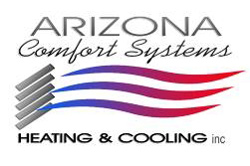
To combat increasing energy expenses and embrace sustainability, many homeowners are trying new methods to maintain comfort levels while using less energy. Included in the Inflation Reduction Act, federal tax credits are available for energy-efficient home upgrades, especially HVAC systems like air conditioners. These credits offer significant savings, as long as the homeowners choose qualifying equipment and submit the right paperwork.
If you’re trying to avoid a long process, we can share something that will help! Arizona Comfort Systems hopes this guide will provide all the information necessary to take full advantage of HVAC tax credits this year. Here’s what you’ll need to do.
Understanding the HVAC Tax Credits
These valuable tax credits for boosting your home’s energy efficiency are just one portion of the recent Inflation Reduction Act. With the higher cost of energy making an impact, helping more homeowners upgrade their equipment is always beneficial. The main intention of these credits is to help pay for high efficiency HVAC equipment and other projects. The two we’ll cover are the Residential Clean Energy Credit and the Energy Efficiency Home Improvement Credit.
Don’t forget, in order to apply for the credits, you’ll have to fill out IRS Form 5695. Additionally, this form is submitted within the same tax year your upgrades were installed, not bought.
Maximizing Savings with the Energy Efficiency Home Improvement Credit
Through 2032, the Energy Efficiency Home Improvement Credit provides up to $3,200 every year for energy-efficient home upgrades. This amounts to 30% of the total project’s cost. You should be aware that in order to receive the maximum amount, it involves making different investments. For example, you’ll save up to $2,000 for installing a higher efficiency heat pump. This can be paired with an additional $1,200 in credits for more projects in the tax year.
While new heat pump systems are a popular option for the tax credit, other HVAC upgrades like efficient furnaces and air conditioners also qualify. It will help to confirm that your choice’s energy efficiency rating is high enough for eligibility.
Residential Clean Energy Credit
The Residential Clean Energy Credit provides 30% savings on a number of other residential clean energy equipment upgrades. Eligibility is only extended to homeowners looking for new clean energy solutions for their home. While the Home Improvement Credit highlights utilities and HVAC systems, this credit targets renewable energy sources like solar and wind energy.
Some provisions of the tax credit include the requirement that installation must occur between 2022 and 2032. But at the same time, homeowners can use any excess credit to reduce taxes in future years. This is a great way to make things a little easier when investing in renewables.
Additional Qualifications for Energy Tax Credits
Because HVAC systems are one of the biggest expenses on your energy bill, these tax credits incentivize the most energy-efficient options. But home energy efficiency can be improved in many other ways. Apart from the previously listed HVAC upgrades, {you could also choose|other eligible items include|you also have access to:
- Heat pump water heaters
- Modern electrical panel improvements
- New electrical wiring
- Enhancements to insulation, air sealing, and ventilation
- Energy-efficient cooking appliances like stoves, cooktops, and ovens
- Heat pump clothes dryers
- Water boilers
Like the HVAC systems, you’ll need to check that your chosen products meet the required energy efficiency ratings.
Maximizing Your 2024 HVAC Tax Credits: Top 3 Tips
While all the listed upgrades can enhance your home's energy performance, some planning ahead will ensure more long-term benefits. Maximize your HVAC tax credits with these reminders:
- Conduct a home energy audit to identify impactful upgrades. Trust experienced HVAC companies to pinpoint essential products and services.
- Improve your home's thermal efficiency with better windows and doors.
- Explore potential rebates from utility companies for clean energy upgrades. Renewable sources like solar, wind, and geothermal contribute to community power grid sustainability.
- Don’t forget financing options from local service companies, which can help reduce costs even more.
Secure Your 2024 HVAC Credits with Help from Arizona Comfort Systems
Partner with local HVAC professionals like Arizona Comfort Systems for help with home energy audits and new installation projects. Our helpful installers can deliver whatever you need for home energy efficiency upgrades.
